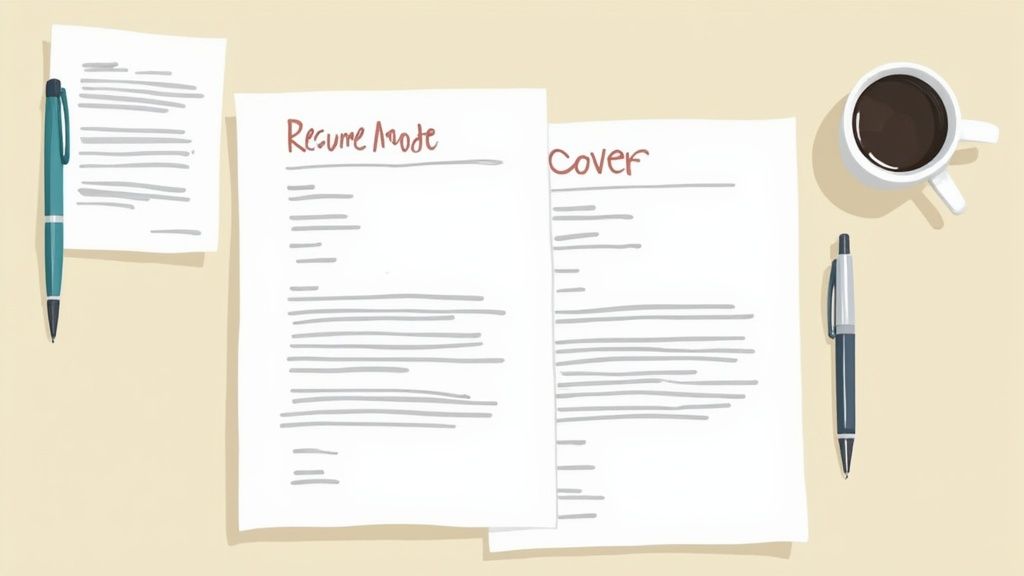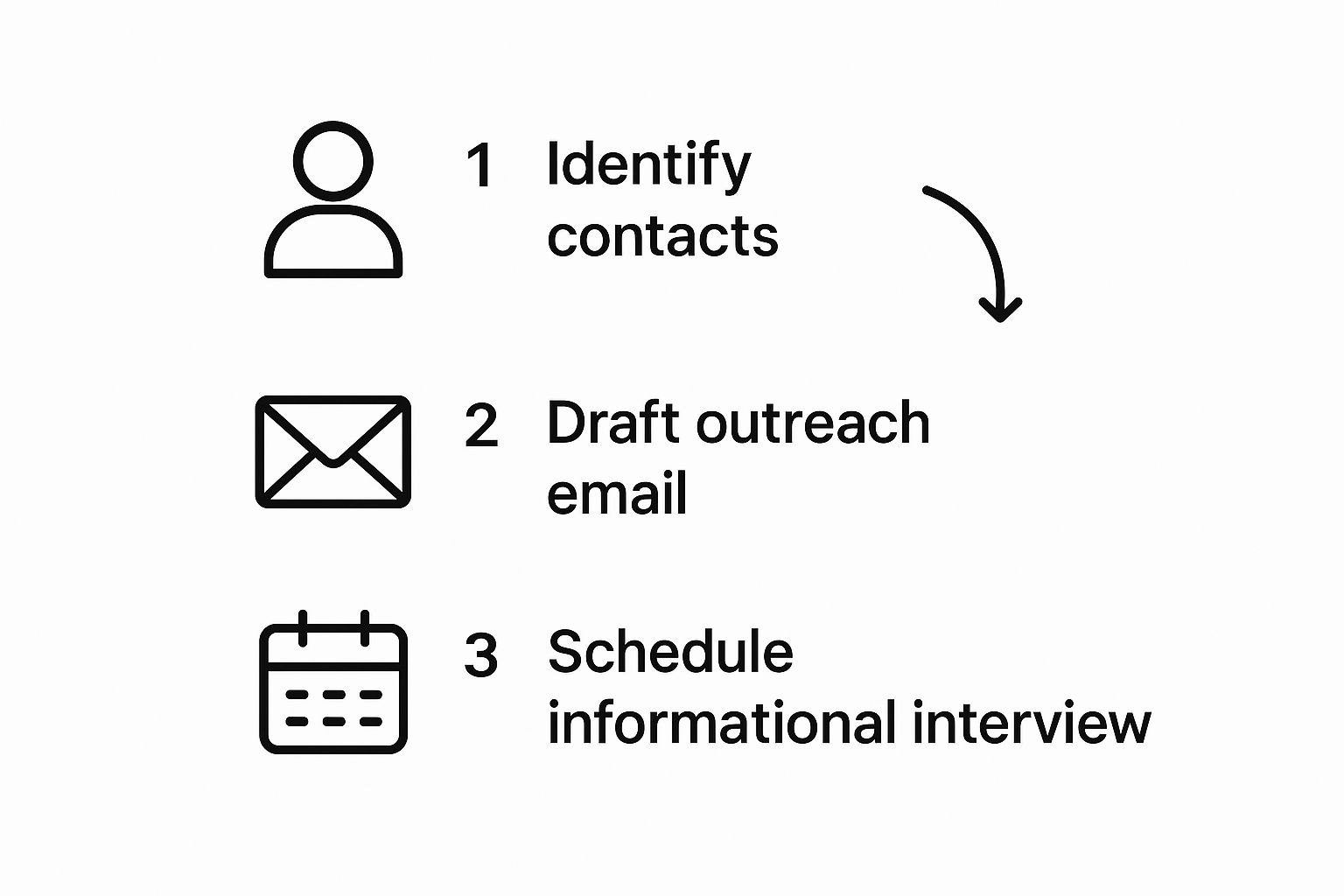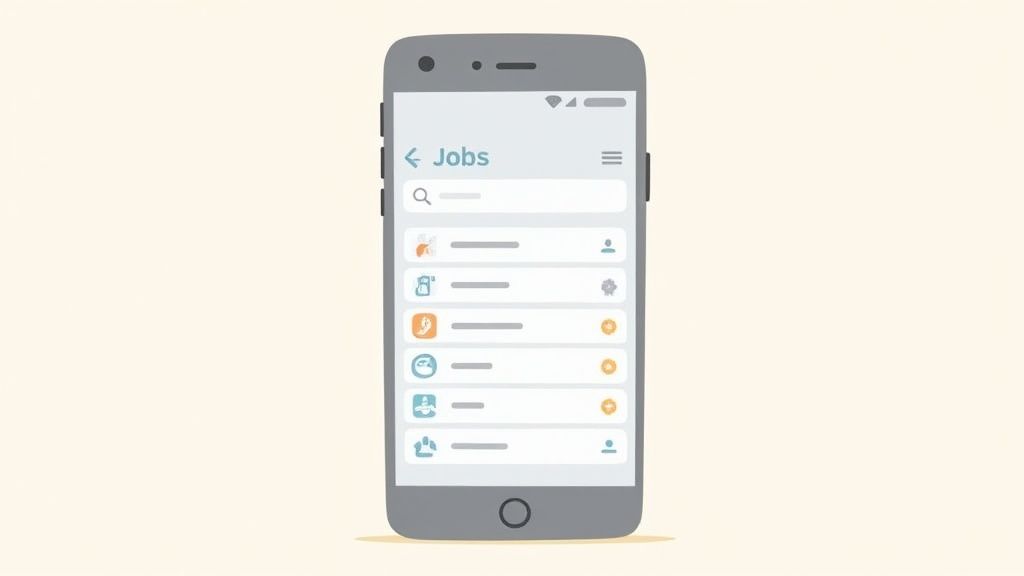
How to Find Internships and Launch Your Career
Finding the right internship really comes down to two things: figuring out what you actually want and then knowing where to find it. Before you even think about applying, you need to clarify your career goals and pinpoint the skills you want to build. This simple first step transforms a vague, overwhelming search into a focused mission.
Laying the Groundwork for Your Internship Search
Before you open a single job board, the most valuable thing you can do is a little self-reflection. I’ve seen countless students take a scattergun approach, firing off applications to dozens of random listings. It almost never works. A truly successful search starts with a clear plan built on knowing yourself. What are you hoping to get out of this beyond just another line on your resume?
Start by asking yourself some direct questions to sharpen your focus. This clarity will be your north star, guiding you toward roles that offer real-world value and line up with where you want to go long-term.
Define Your Ideal Internship Experience
Take a minute and really picture what a “successful” internship looks like for you. Are you determined to learn a hard skill, like Python for data analysis, or are you more interested in developing soft skills like project management? Nailing this down will help you filter out the noise.
Think about these key factors:
- Skill Development: What one or two skills are absolute must-haves for you to learn during this experience?
- Industry Exposure: Are you trying to get your foot in the door in a specific field like tech, finance, or a non-profit?
- Company Culture: Do you see yourself thriving in the high-energy, “all-hands-on-deck” vibe of a startup, or would a more structured corporate environment be a better fit?
- Mentorship: How critical is it for you to have a dedicated mentor who can show you the ropes?
Getting clear on these answers helps you immediately discard irrelevant roles and focus your energy on the opportunities that will actually move the needle for your career. From day one, it’s smart to keep everything organized. Using a simple job application tracker can be a game-changer for staying on top of it all.
My Two Cents: Don’t just look for an internship; search for your internship. The more specific you are about your goals, the easier it becomes to spot the perfect opportunity when it pops up.
For instance, take a look at the search interface on a platform like LinkedIn. It’s packed with filters for industry, location, and job type.

These filters are only powerful once you’ve actually defined what you’re looking for. It’s how you turn a massive, intimidating database into a curated list of solid leads.
Finding Hidden Internships Beyond Job Boards

The best internships—the ones that give you real, meaningful work—almost never show up on the big job boards. They live in what insiders call the “hidden job market.” If you want to find a role with serious responsibility and sidestep the hundreds of other applicants clicking “apply,” this is where you need to look.
This means you have to get proactive. Instead of passively scrolling through listings, you’ll be actively hunting for opportunities. The whole game changes when you identify companies you genuinely admire and reach out to them directly. It puts you on their radar long before they’ve even thought about writing a job description.
Uncover Opportunities at High-Growth Companies
Your first move should be to target startups and other fast-growing companies in your industry. These places are often scaling so quickly that their hiring needs get way ahead of their ability to build out a formal internship program. They’re usually far more open to a motivated student who shows up with a great attitude and a willingness to learn.
So, how do you find them?
- Become an industry insider. Start reading the same tech blogs, business journals, and trade publications the professionals do.
- Follow the money. Check out websites that track venture capital funding. A company that just landed a big investment is almost certainly about to go on a hiring spree.
- Join the conversation. Get active in industry-specific forums, Slack communities, or Discord servers. This is where people talk about the companies that are actually doing interesting things.
Once you’ve built a solid list of companies, you’re ready to make your move with a speculative application. This isn’t just a generic cover letter. Think of it as a direct pitch showing them exactly what you can do for them.
Expert Tip: Your outreach should be about solving their problems, not yours. Don’t just say, “I’m looking for an internship.” Instead, try framing it around how your skills could help them with a specific challenge or project you know they’re working on.
Leverage Your University and Alumni Network
Don’t sleep on your school’s career services office and alumni network—they’re absolute goldmines. You’d be surprised how many alumni are happy to help out a student from their alma mater. They can give you the inside scoop on their company, pass your name along to the right person, or sometimes even create a role for you on the spot if you impress them.
Start digging through your university’s alumni database or use the alumni search feature on LinkedIn. Find people who are working in roles or at companies that excite you. Then, send a short, professional message asking for a quick informational interview to hear about their career journey. The key here is not to ask for a job directly. Focus on building a relationship first; it’s a much more powerful approach.
Explore the World of Global Remote Internships
Remote work has completely blown the doors off what’s possible for internships. You can now get incredible international experience without ever leaving home. These roles give you a chance to build cross-cultural skills and work with teams from all over the world—a huge plus for your resume.
This isn’t just a niche trend; it’s exploding. Students are hungry for career experience that also offers a global perspective. The numbers don’t lie: recent data shows a massive 69% year-over-year jump in views for internships in China and a 43% spike for roles in Spain. Even established markets like England saw a 25% increase. This shows just how much students value the dynamic experience of working internationally. You can dive deeper into these global internship statistics to see what’s driving the demand.
Crafting an Application Recruiters Can’t Ignore
You’ve got about seven seconds. That’s the average time a recruiter spends scanning a resume before deciding if it’s worth a closer look. In that tiny window, your application has to scream, “I’m the one.”
A generic, one-size-fits-all resume just won’t make the cut, especially when you’re up against a sea of other ambitious students. The real secret? Making them feel like you prepared this application just for them. It’s all about tailoring your message.
Mirror the Job Description
Think of the job description as your roadmap. It’s the company literally telling you what they want. Your mission is to connect the dots between your experience and their needs, using their exact language.
Start by breaking down the “Requirements” or “Qualifications” section. If they’re asking for “experience with social media analytics,” your resume had better have a bullet point that speaks directly to that. Even if it was for a class project, frame it in a professional light.
Let’s say the description asks for teamwork and research skills.
- Instead of: “Helped with a group project.”
- Try: “Collaborated with a four-person team to research market trends, contributing to a final presentation that received top marks.”
This isn’t just about impressing a person; it’s about getting past the machines first. Many companies use an Applicant Tracking System (ATS) to scan resumes for specific keywords. If your resume doesn’t have them, a human will likely never see it.
For a complete breakdown of how to build a resume that gets noticed, check out our guide on how to write a student resume.
Translate Experience Into Impact
I hear it all the time: “But I don’t have any real experience.” That’s one of the biggest myths out there. Your academic projects, volunteer work, and part-time jobs are loaded with skills that companies want. You just need to learn how to frame them.
Did you manage the budget for a campus club? That’s financial management. Did you organize a fundraising event? That’s project coordination and leadership. The trick is to always focus on quantifiable results.
Key Takeaway: Don’t just list what you did; show what you accomplished. Numbers are your best friend. How many people attended the event you planned? By what percentage did you boost your club’s social media engagement? Concrete metrics make your contributions feel real and significant.
The image below gives you a great visual for how to get on a company’s radar through proactive networking.

It’s a simple process: identify key people, send a personalized message, and get a conversation on the books. This is how you find those amazing opportunities that are never even posted publicly.
Tell a Story with Your Cover Letter
Your cover letter is where you bring your resume to life. It’s your chance to add personality and show genuine passion, connecting the facts on the page to the person you are. Don’t just repeat your resume—tell a story.
A great cover letter needs to do three things:
- Grab their attention immediately. Start with a powerful opening that shows you know the company and are genuinely excited about their mission.
- Connect your experience to their needs. Pick one or two achievements from your resume and expand on them. Explain how those skills will directly benefit their team.
- Show your passion. End with a clear, confident statement about why you want this specific internship and what you hope to contribute.
To make sure your resume is packed with the right terms, use this checklist to pull keywords directly from the job description.
Resume Keyword Optimization Checklist
Use this checklist to ensure your resume is optimized with keywords from the job description to get past automated screening systems (ATS).
| Checklist Item | Example/Action |
|---|---|
| Identify Core Skills | Scan the “Requirements” section. If it lists “SQL,” “Python,” or “Project Management,” ensure those terms are on your resume. |
| Note Action Verbs | Look for verbs like “analyzed,” “developed,” or “managed.” Use these same verbs to describe your own experiences. |
| Include Company-Specific Lingo | If the company mentions a proprietary tool or a specific methodology (e.g., “Agile”), include it if you have relevant experience. |
| Check for Synonyms | The description might say “customer relations,” while your resume says “client support.” Align your language with theirs. |
| Quantify Achievements | Pair keywords with numbers. Instead of “Managed social media,” write “Managed social media, growing engagement by 25%.” |
By systematically aligning your resume with the job description, you’re not just hoping to get noticed—you’re making it impossible for them to ignore you.
Unlocking Opportunities Through Networking

Sure, you can spend hours firing off applications into the digital void, but let’s be honest: a strong professional network opens doors that job boards just can’t. Many of the best internships are filled through referrals long before they ever get posted publicly.
This isn’t about collecting hundreds of random connections. It’s about building genuine relationships. When you learn how to network the right way, you get access to insider knowledge, candid advice, and a hidden job market. It’s your single biggest advantage.
The Power of Informational Interviews
One of the best-kept secrets of effective networking is the informational interview. Think of it as a low-pressure chat with someone working at a company or in a field that fascinates you. The goal here isn’t to ask for a job—it’s to ask for advice.
You’d be surprised how willing people are to talk about their careers. A simple, well-crafted message can land you a 20-minute conversation that provides a ton of value. You’ll learn what the industry is really like, get a feel for a company’s culture, and discover which skills actually matter on the job.
Pro Tip: Always wrap up an informational interview by asking, “Is there anyone else you think would be good for me to talk to?” This one question can turn a single connection into several, expanding your network faster than you’d think.
Mastering Your LinkedIn Outreach
LinkedIn is your best friend for this strategy. But before you reach out to anyone, your profile needs to be sharp. It’s non-negotiable. It has to clearly communicate your skills and what you’re looking for in your career. For a full breakdown, check out our guide on how to optimize your LinkedIn profile for success.
When you’re ready to connect, personalization is everything. Do not use a generic, copy-pasted template. Your message should be short, respectful, and show you’ve done your homework.
Here’s a simple script I’ve seen work time and time again:
- Subject: Question from a [Your Major] Student
- Message: “Hi [Name], I came across your profile and was really impressed by your work on [Their Project or at Their Company]. As a [Your University] student passionate about [Your Interest], I’d be grateful for the chance to ask you a few questions about your career path. Would you have 15 minutes for a brief chat sometime in the next few weeks?”
This approach works because it’s direct, it respects their time, and it focuses on their expertise. It proves you’re serious and not just another random request.
Making an Impact at Career Fairs
Career fairs can feel like a chaotic mess of students and recruiters, but they’re golden opportunities if you have a game plan. Don’t just wander around grabbing free pens.
Before you even step foot in the door, you should:
- Do your homework. Research the companies that will be there and pick your top five to ten targets.
- Nail your “elevator pitch.” Practice a 30-second summary of who you are, what you’re studying, and the kind of role you’re hoping to find.
- Prepare smart questions. Go beyond “So, what do you do?” Ask something insightful about a recent project or a piece of company news. It shows you’re genuinely interested.
The most important step? Follow up. Send a personalized email to the recruiters you spoke with within 24 hours. Reference something specific from your conversation to jog their memory. This simple gesture puts you head and shoulders above most other attendees.
In a market that’s getting tighter, these networking efforts are more important than ever. Recent data shows internship listings dropped by 14.7% in just one year. Still, about 41% of U.S. college students land at least one internship, making it a competitive but essential career step. You can dig into more of these trends in internship statistics to get the full picture. Building your network is the surest way to get a leg up.
Navigating the Interview and Offer Process
Alright, you’ve landed the interview. That’s a huge milestone, but now it’s game time. This is your chance to prove you’re more than just words on a page. It’s where all your research, passion, and personality need to shine and convince them you’re the right person for their team.
Honestly, winging it just doesn’t work. Success in an internship interview comes down to solid preparation. This means going way beyond a quick glance at your resume right before the call. You need to get inside the interviewer’s head, anticipate their questions, practice your answers, and come up with some smart questions of your own.
Answering Common Interview Questions
Most interviews for internships are a mix of two things: questions about your past experiences (behavioral) and questions that test your actual skills (technical). The behavioral ones are designed to see how you think and act in real-world work situations.
For these, the STAR method is your secret weapon. It’s a simple framework that keeps your answers clear, concise, and powerful.
- Situation: Set the scene. What was the project or challenge you were facing?
- Task: What was your specific role? What were you supposed to accomplish?
- Action: Detail the specific steps you took to get the job done.
- Result: What happened in the end? This is where you bring in the numbers. Quantify your success whenever you can.
Using STAR stops you from rambling. Instead of saying, “I worked on a team project,” you can tell a quick, compelling story about your exact contribution and the awesome results that followed. It’s way more memorable.
Asking Questions That Make an Impression
You know that moment at the end of every interview when they ask, “So, do you have any questions for us?” This isn’t just a formality—it’s your final test. Don’t blow it with a generic question you could have Googled.
Key Takeaway: The best questions show you’re thinking about the company’s future and how you’ll fit into it. Dig deeper than their “About Us” page. Look up recent press releases, read about challenges in their industry, or ask about a specific project they just launched.
This kind of detailed question shows you’re not just looking for any internship. You’re genuinely interested in their company and what they’re trying to achieve.
Addressing Unique Challenges and Securing the Offer
Let’s be real—the playing field isn’t always level. Some students face bigger hurdles than others. For example, international students can have a particularly tough time landing off-campus roles. In fact, research shows only 25% of international students secure an off-campus internship, compared to 42% of their domestic classmates.
The good news? Engagement is high, with 85% of these students actively using campus career services to get help. You can read more about these international student employment trends. It’s a powerful reminder to use every single resource you have available to push past any barriers.
When that offer finally comes in, take a breath. And remember, you often have more power than you think. Don’t be afraid to negotiate. This isn’t just about the money; you can often discuss your start date, the specific projects you’ll work on, or even mentorship opportunities. A polite, well-thought-out request shows you’re a confident professional, ready to start your career on the right foot.
Answering Your Top Internship Questions
Finding an internship can feel like you’re trying to solve a puzzle with half the pieces missing. To clear things up, I’ve put together answers to the questions I hear most often from students. Think of this as your personal cheat sheet for navigating some of the trickiest parts of the search.
When Should I Actually Start Applying for Summer Internships?
This is a classic question, and the answer is: it really depends on your industry.
If you’re aiming for those hyper-competitive gigs in finance, consulting, or at a big-name tech company, the timeline is shockingly early. You need to have your resume in top shape by late summer because applications often open in August and September for the following summer. It’s a whole different ballgame.
For most other fields, things are a bit more reasonable. The prime application window is usually between January and March. But here’s the real pro-tip: don’t wait until January to start thinking about it. Do your homework in the fall. Figure out which companies you’re excited about and learn their typical hiring schedules. That way, you’re ready to pounce the second an application goes live.
What if I Have Zero “Real” Experience?
Everyone starts here. Seriously, every single person in your dream job once had a resume with no professional experience. The key is to shift your perspective on what “experience” actually is. Hiring managers aren’t just looking for a carbon copy of the last intern; they’re looking for potential.
So, how do you show it? Focus on your transferable skills. These are the abilities you’ve built that can easily carry over to a professional environment. Dig into your past and find examples of:
- Problem-solving: That ridiculously hard group project where you figured out a new way to analyze the data? That counts.
- Teamwork: Every collaborative assignment or club activity is fair game.
- Communication: Did you work retail or a campus job? You’ve got customer service and communication skills down.
Even better, create your own experience. Build a simple portfolio website, write a few blog posts about your industry, or manage social media for a campus club. These kinds of projects scream initiative and genuine interest, which can be far more impressive than a generic entry-level task on someone else’s resume.
Your cover letter is your secret weapon when your resume feels a little light. It’s your chance to connect the dots for the hiring manager and tell them a story. A compelling narrative about your passion and drive to learn can absolutely outweigh a lack of formal experience.
Should I Even Consider an Unpaid Internship?
This is a tough one, and you need to tread carefully. My general advice is to always prioritize paid internships. Your work has value, and you deserve to be compensated for it.
However, there are a few rare instances where an unpaid role might make strategic sense. Is it a once-in-a-lifetime opportunity at a world-renowned museum? Will you be mentored directly by a legend in your field? If the experience offers something truly invaluable that you can’t get anywhere else, it might be worth considering.
Just make sure it’s legal. In the United States, for an internship to be legally unpaid, it has to be structured for your benefit, not the company’s. You should be learning, not just doing free work.
How Do I Follow Up After an Interview Without Being Annoying?
Following up is an art form—it shows you’re interested and professional, not desperate. The first step is non-negotiable: send a thank-you email within 24 hours of the interview.
Keep it short and sweet. Thank them for their time, briefly mention something specific you enjoyed discussing (this proves you were paying attention), and reiterate your excitement about the role. It’s a simple gesture that makes a huge difference.
If they gave you a timeline and that date passes, it’s perfectly fine to send a single, polite follow-up email. Just check in and ask if there are any updates. The goal is to be professionally persistent, not a pest.
Ready to stop scrolling and start applying? Jobcamp uses AI to instantly create customized resumes and cover letters for any job posting, helping you apply to more roles in less time. Get started for free and land your dream internship faster.

